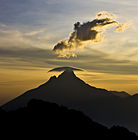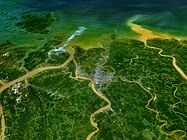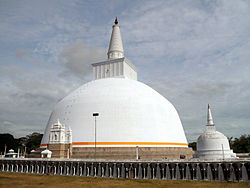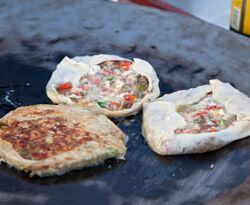User:Occred/Sandbox2
| Motto: "ఉమాఫా శివుక ఞెంగెణ్యంగా." "Umafa sivuka njengenyanga." "We rise like the moon." | |
| Anthem: ఇగుగు లోకరహేయ్ 'Igugu loKarahey' ("Jewel of the Karaihe") | |
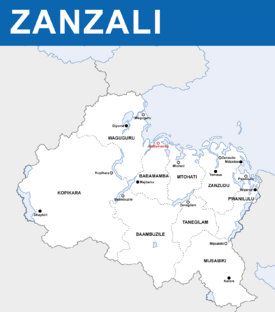 Political Map of Zanzali | |
| Capital and largest city | Babamamba |
| Official languages | ShiZanzi |
| Recognised regional languages | |
| Ethnic groups | |
| Religion | List of religions
|
| Demonym(s) | UmZanzi (sing.) MaZanzi (pl.) |
| Government | Kritarchy with democratic and aristocratic characteristics |
• Kwelanga ("sunshine", chief justice) | [[<<NAME>>]] |
• Bandhala (chancellor? political leader) | [[<<NAME>>]] |
• Ilizwi (voice, legislative leader) | [[<<NAME>>]] |
• Lokomatha (chief abbot, religious leader) | [[<<NAME>>]] |
| Legislature | Yengxoxo |
| Independence from the Mutul | |
• Tahamaja colony | 936-1353 CE |
• Pirate republics | 1353-1680 |
• Maok'ab client state | 1680 - 5 July 1841 |
• Uxanduvate | 23 March 1878 - present |
| Area | |
• Total area | 698,560 km2 (269,720 sq mi) |
• Water (%) | 9 |
| Population | |
• 2020 census | 44,009,280 |
• Density | 63/km2 (163.2/sq mi) |
| GDP (nominal) | 2020 estimate |
• Total | $1,122,236,640,000 |
• Per capita | $25,500 |
| Gini (2020) | medium |
| HDI (2020) | very high |
| Currency | biya (Z฿) (ZZP) |
| Time zone | UTC+2 |
| Date format | dd/mm/yyyy |
| Driving side | right |
| Calling code | +258 |
| Internet TLD | .ZZ |
Zanzali (/zɑːnzɑːliː/; ShiZanzi: ఎట్సండ్జల్, eTsandzale), officially the Uxanduvate of Zanzali (ShiZanzi: ఉబుక్సందువ ఎట్సండ్జల్, Ubuxanduva eTsandzale), is a country in southeastern Malaio situated on the Karaihe Sea, bordering Pulau Keramat to the north, Pulacan to the west, and Onekawa-Nukanoa to the east. Its population of 44,009,280 is concentrated on the tropical coast, with much of the rest of its 698,560km2 area being arid and relatively sparsely populated. The capital and largest city of Zanzali is Babamamba, with other major urban areas including Lembalemba, Kabaweyo, and Thangana. Its majority and official language is ShiZanzi, the southernmost Komontu language.
For much of prehistory, Zanzali was occupied by Tuganani peoples, who would eventually be pushed out of the region, or otherwise assimilated, by Komontu migrants who began arriving en mass in the early 500s CE. Beginning in the 10th century CE, the area that is now Zanzali was utilized as a penal colony by the Tahamaja Empire, where criminals and dissidents from throughout the Ozeros region were sent to work mining gemstones and growing coffee and nuts alongside local Komontu and Tuganani tribes. The mixing of these groups gave rise to the MaZanzi, which today are the largest group in Zanzali. This constant influx of criminal elements led to the region becoming known for its skilled mercenaries, smugglers, and pirates, who eventually became the main authorities in Zanzali after the collapse of the Tahamaja in the 1300s, leading to the rise of many pirate republics in the region. These republics came under the suzerainty of the Mutulese Yajawil of Maok'ab by the late 17th century. In 1841, the MaZanzi republics gained their independence from Maok'ab, and joined in 1863 under a union of religious courts which would evolve into the modern state.
Zanzali's political history has been defined by a unique system of rule by religious judges, called unamuzi, and a "big man" dynamic characterized by spectacle. The Uxanduvate is offically a unitary state which practices devolution across 9 viceroyalties. Power is balanced between the central judiciary, aristocratic clans, and popular petitions and referenda. Zanzali is a minor power and a member of many international organizations, such as AON, the Forum of Nations, and the Joint Space Agency. It has a developed economy, with a GDP per capita of $25,500, with major industries including tourism, textiles, and chemical production. Industrial agriculture and food processing is also a major component of the economy, with coffee, seafood, tobacco. and spices, particularly vanilla, being mainstays. Despite a relatively strong economy and high HDI of .804, Zanzali is known for its high income inequality, with a GINI coefficient of 44.3. Likewise, while it ranks well in many international comparisons of quality of life, Zanzali has been criticized for its lack of human rights protections and inconsistent public services.
Etymology
The name Zanzali is derived from the Middle ShiZanzi verb tsandza, "to weave, to love", which forms the word eTsandzale, "this beloved country". Originally transliterated as Sanjalay, this name only came into use following the rise of anti-colonial movements in the 18th century, and entered its modern form around the 1850s. It has also been suggested that the adjective mazantsi, "south", had some influence on the modern name and demoynms.
Before the widespread adoption of eTsandzale, the area encompassing modern Zanzali was variously called Thankata (from Mataram tanah kidul, "south shore", the origin of the name of modern Dankada) and Besirang (from Mataram pesisir ireng, "black coast").
A person from Zanzali, or a member of its dominant ethnic group, is called an "UmZanzi" (/ʊmzɑːnziː/), the plural being MaZanzi (/mɑːˈ-/). Historically, "Zanzalese" was used as a demonym, but this is now considered archaic or poetic.
"Uxanduvate" entered usage as a formal national title in 1878, being coined a century earlier to describe realms overseen by monastaries and judges, as opposed to Mutulese batabs. It comes from the ShiZanzi word uxanduva, literally "obligations, arrangements", and evokes the cultural and religious responsibilities upon which the MaZanzi state is based.
Geography and climate

Zanzali is approximately 713,600km2 (275,523 square miles) in area, located on the southern shore of the Karaihe Sea in southeastern Malaio. It borders Onekawa-Nukanoa to the east, along the Hanaki River and accompanying swamplands, and the Javinassa peninsula of Pulau Keramat to the north, where the border is partially defined by the Javinassa Mountains, which lower into the Djebe Highlands which form a border with Pulacan to the west.
Zanzali's physical features are characterized by the dichotomy between the wet, tropical coast in the north and the semi-arid, rugged southern interior. Southern Karaihe coastal forests are broken up by coastal swamplands, particularly East Malaioan mangrove forests and MaZanzi flooded savanna, host thousands of diverse plant and animal species and support extensive fishing, agriculture, and tourism industries. The Zoka, Mbizi, Ndzeya, and Hanaki rivers (listed west-to-east by the location of their estuaries) are the country's principle waterways, meandering north from the interior hills into the Karaihe Sea, creating numerous lakes, swamps, and floodplains along the way. The Hanaki river is Zanzali's widest river, spanning 22 kilometers (13.6 miles) across at its widest point, while the Zoka River is the longest, winding 1220 kilometers (695 miles) from Lake Ntsiɗwe on the country's southwestern border to its outlet near the city of Kabaweyo.
Annual monsoons from May to November inundate coastal regions, with some areas receiving more than 1500 milimeters (60 inches) of rain annually. While the rainy season is also, on average, the warmer part of the year, it is rare for temperatures on the coast to deviate much outside of the range of 25°C-30°C (77°F-86°F). Moving away from the coast, there is a rapid transition to tropical savanna and miyombo woodlands, accompanied by a rise in elevation. This rise means that most major waterways were not fully navigable, due to rapids and waterfalls, until the construction of a system of locks and canals in the 20th century.
The southern half of the country consists mostly of semi-arid hills, featuring mobane woodlands in the river valleys and drier interior miyombo woodlands in elevated areas. Temperatures are typically similar to the coasts, but rain is much scarcer, with most areas receiving less than 500 milimeters (20 inches) of precipitation annually. This hot, dry hinterland is broken up by high plateaus featuring a contrasting subtropical temperate climate, hosting montane forests and grasslands. Temperatures are comparatively mild and consistent year-round in these regions, usually staying between 10°C-22°C (50°F-76°F). These highlands are the southern terminus of the larger Great Malaioan Rift, a system of lakes, mountains, and highlands running the length of the continent.
Zanzali is also on the southern edge of the Karaihe Ecological Intermediate Zone, a transitional area wherein three distinct biogeographical regions meet: the Malaio Rift savannas, the Ozeros tropical rainforests, and the Onekawan temperate woodlands, all centered around the Karaihe Coral Archipelago, a group of atolls and coral reefs throughout the Karaihe Sea which form one of the largest concentrations of coral and marine life in the world, protected by the internationally-administrated Karaihe International Marine Preserve. The Intermediate Zone features diverse flora and fauna from each of these regions, and Zanzali in particular hosts giraffes, both Ozerosi and Malaioan elephants, rhinoceroses, and other animals, which contributes to a thriving eco-tourism sector and zoological community.
History
The eastern coast of Malaio is one of the oldest continually inhabited regions on Earth. Stone tools exacavated from archaeological sites in Zanzali's northwest have been dated back to as early as 100,000 years ago, and fossil specimens elsewhere have been dated as from between 300,000 and 200,000 years ago. Zanzali's indigenous inhabitants are believed to have been various xKhasi-speaking peoples, who practiced hunter-gatherer lifestyles among the lakes and savannas.
Approximately 6,000 years ago, Proto-Karaihean speakers began settling the coasts of southeastern Malaio, displacing xKhasi-speakers and pushing them further into the hinterlands. Those who settled in Zanzali and the Javinassa peninsula would eventually develop into the various Tuganani peoples. In the swamplands of northwestern Zanzali, around 3500 BCE, the Tuganani Tiom civilization (a historiographical term) became one of the cradles of civilization. The Tiomi practiced sophisticated environmental engineering through the draining of swamps and irrigation of surrounding areas, allowing them to cultivate crops such as bannanas, sugar cane, and taro. They also practiced a form of early ironworking. Tiomi city-states dotted the coast of the Karaihe Sea and saw frequently trade and conflict with Proto-Onekawan and xKhasi groups on their frontiers. Archaeological finds suggest that Tiomi goods were traded as far as modern Fahran and Kajera. The Tiom civilization began to decline around 1000 BCE, possibly due to a prolonged drought in the region.
Beginning around 200-500 CE, the final stages of the millennia-long Komontu migrations began to reach southern Malaio. Practicing slash and burn agriculture alongside nomadic cattle pastorialism, they initially migrated south along the coast before reaching what is now Isibhaka in western Zanzali. From here, they gradually spread out and began to mix with the local xKhasi and Tuganani populations, the latter of which heavily influenced their agricultural and ironworking techniques, eventually forming the foundations of the modern MaZanzi ethnic group. Further migration southeast along the coast was prevented by aggressive defense of their territory by Onekawan tribes. This is the subject of a mythical folktale in the region which has many variations, but is broadly described a century-long conflict between tribes on both sides of the Hanaki River.
While these Proto-MaZanzi groups ceased to be nomadic, they form polities much larger than an individual large village during this period. The concept of the "big man" began to crystalize in this time, in which settlements lacked formal leadership beyond those who helped mediate disputes and led the organization of community efforts. Large herds of cattle, which were novel for surrounding Kairehean populations, often represented the collective wealth of the village. While Komontu beef was a popular export in the region, cheese took several centuries to catch on. By the late 700s CE, the Proto-MaZanzi were also beginning to serve as middlemen between groups in the southern Malaioan interior and the greater Ozeros Sea, moving gold and gems north, attracting the attention of the budding Tahamajan empire.
Age of Pearls
In the early 900s CE, military expeditions from the Grand Tahamaja began arriving along the coastline of modern Zanzali in the beginning of the period now termed the Age of Pearls. Having fully consolidated control over their home islands, Za’gree elites sought avenues for economic expansion throughout the Karaihe and lower Ozeros. This began with trading outposts on the coast, and gradually expanded to include tributaries further inland. However, the inhospitable terrain prevented full-scale colonization beyond the immediate coastline.
Tahamaja rule also brought N'nhivara to the MaZanzi coast. Many MaZanzi tribes converted en mass, either due to the mass adoption of immigrants or in order to secure favorable arrangements with Tahamajan authorities. Temples and monastaries became centers of political and economic importance, bringing consistent development and resources in their wake. Typically, these Mzanzi converts would syncretize N'nhivara with traditional folk religion, incorporating beliefs about a creator-and-sky god and ancestor worship.
Although the region was initially valued for its connections to the interior's gold and ivory trades, under Tahamaja rule it quickly became a major center for the production of sugarcane and spices (such as nutmeg and cinnamon) as well. Not wanting to enslave large numbers of locals for fear of disrupting the steady flow of valuable goods from the interior, in 933 Pelutama Garaj Ritarja Anukana ordered that coastal plantations be populated with enslaved criminals and political dissedents from throughout the Tahamaja. This resulted in an influx of diverse cultures from throughout the Ozeros as enormous numbers of prisoners were pressed into hard labor each year, ballooning the population. Between 933 and 1000, it is believed that the territory's population grew as much as 300-500%. These imported ethnicities were generally assimilated into existing Proto-MaZanzi clans, either as side effect of Tahamajan bargaining or by choice of individuals either fleeing slavery or purchasing their own freedom, gradually creating a vast ShiZanzi-speaking creole group which would become the majority population of the region, encompassing Komontu, Tuganani, and countless pan-Ozerosi influences.
The sheer number of criminals and political dissidents among the original colonial population fueled a rich, boisterous tradition of rebellion against Tahamajan authorities. This took many forms, ranging from defiance of colonial borders and taxes to open insurrections. Fraud, smuggling, and free movement of entire groups of people were common. As military service was a relatively straightforward way to secure one's freedom, and generally took less time than saving up enough money to purchase freedom, the region also became famous for its sailors and mercenaries, particularly versatile ikrele-wielding troops who were known to be as capable on horseback as trudging through coastal swamplands. These troops were used extensively by the Tahamaja in military campaigns throughout the Ozeros alongside many other auxiliaries, such as the Onekawan Kaiponu Tauā.
With the eruption of Mt. Siriwang in 1353, the Tahamaja entered a period of violent decline. In the Karaihe, this took the form of local administrators being replaced by regional warlords, often mercenary commanders tied to local clans. By the year 1400, the last vestiges of colonial governance had crumbled and given rise to nearly thirty independent MaZanzi polities.
Age of Fire
The period following the collapse of the Tahamaja in Zanzali is historiographically referred to as the Age of Fire. Fierce competition between warlords and minor principalities or republics became the norm, and the cultural concept of shehena fully crystalized. Shehena encompasses the concept of treasure or cargo brought back from raids or trade expeditions, which is then redistributed among the clan and community in order to bolster the reputation of the ones who retrieved it. This would rapidly become the focal point of MaZanzi politics in the power vacuum left by the Tahamaja, resulting in many families sending their sons abroad, either as warriors or merchants, to bring back new wealth, spreading MaZanzi individuals across the Ozeros while simultaneously importing vast foreign cultural and economic influences in return. Piracy, ritualistic battles, and major public works projects became the norm, particularly among the coastal states, but no MaZanzi polities managed to deliberately project power outside of their immediate Karaihe neighborhood.
Eventually, the N'nhivara monastaries and temples that had once served as the epicenters of Tahamaja economic power re-emerged as the arbiters of disputes between warlords. Seen as neutral middlemen, N'nhivara monks would be entrusted as mediators and guardians of the peace; in many areas, they would resume their economic role, this time receiving a portion of shehena from all local rulers to be redistributed to the needy or to organize key industries, such as papermaking or dyeworks. Thus, the temples were locked into a constantly shifting balance of power the with warlords and magistrates, masked by their religious and economic functions. Their actual, functional power ranged from purely ceremonial, giving legitimacy to the rule of local lords, such as in Umayeye, to being the de facto authorities in a region, such as in Obuzima, which was the heartland of the the largest coherent political entity in Zanzali in this period, the Ivory Porte.
In 1463, the Gharib qadi az-Zubayri arrived in Kabaweyo, becoming leader of the nascent 'Iifae community there. Founder of the Zubayriyah tariqa, he spread Azdarin to Zanzali and the southern Ozeros region. Characterized by lenient positions on taboos, veneration of local spirits, and the use of music, hashish, and dancing in worship, Zubayriyah grew popular in the region and, to varying extents, syncretized well with N'nhivara and local folk religions. With time, this led to increased contact and trade with Fahran and the northern Ozeros region, bring the trade languages of Shimikomwii and Nyelele to the MaZanzi coast. By the mid-1500s, Zanzali was a thriving center of the Azdarin faith, known as a pluralistic safehaven and entrepot throughout the region, connecting the Gharib, Zacapine, Pulaui, Kayatmani, and Shamabalese worlds.
Maok'ab period
During the 17th century, much of the Ozeros came under the suzerainty of the Mutulese empire. Mutulese trade companies, the Nuk Nahob, began establishing trade ports throughout the region, from which they established a monopsony over valuable goods and controlled shipping in the Ozeros Sea and Makrian Ocean. While the Divine Throne did not establish direct colonial control over much of the region, many groups throughout the Ozeros were heavily employed as mercenaries and sailors by the various Nuk Nahob, and workers or slaves were moved huge distances to meet economic desires, contributing to massive migrations of peoples across the region in what is sometimes described as a resurrection of the dynamics of the Grand Tahamaja. In 1680, the Mutulese possessions along the southeastern Malaio coast, from Sina’uia to Montunui, were integrated into the Yajawil of Maok'ab, which Zanzali would remain under until it gained independence in 1841.
Zanzali benefited greatly from arrival of the Mutulese. Increasing amounts of international trade opened new avenues for the collection of shehena, through trade, service, and piracy; Mutulese plantation owners imported vanilla and kakaw to grow as cash crops, and also introduced raised field agriculture throughout Zanzali's vast coastal swamplands and interior river valleys. Gold, ivory, and gemstones funneled from the interior were also highly valued by Mutulese companies seeking to compete with Zacapine interests in Pulacan, leading to several proxy wars in the Djebe Highlands.
MaZanzi piracy in the Ozeros was largely tolerated by the Mutulese for some time, seen as a rounding error, compared to the vast amounts of trade flowing through the region, that would be more expensive to fix than to let go. This changed with the First Shamabalese Great War from 1638-1645, which saw a massive influx of Mutulese military forces into the Ozeros, and gave the Mutul both the pretense and capability to crack down on the MaZanzi pirate-lords once and for all. Mutulese trade ports and districts in Zanzali asserted political-military authority over the surrounding cities; holdings were reorganized under the authority of batabs ("mayors"), pro-Mutul and Mutul-educated elites who handled matters of security, justice, and taxation. Over time, the batabs began sharing responsibilties with the Nn'hivara monastaries in an attempt to keep local lords weak.
Anti-colonial sentiment gradually took root throughout Zanzali, directed at both the Mutulese themselves as well as the Nn'hivara institutions that shared power with them. One manifestation of this was a widespread rejection of both Nn'hivara and, due to the popularity of White Path among colonial elites, polytheism. This led to a mass conversion to of Nn'hivarans to Azdarin beginning in the 1670s, which was soon hijacked by the spiritual leader <<NAME PROPHET>>. <<NAME PROPHET>>'s teachings would eventually inspire the formation of the Grand Ubugaqo Malasa in 1693, widely considered the beginning of the religion of Ubugaqo, now the dominant and state religion of modern Zanzali. The Grand Malasa slowly began to subsume the roles of the Nn'hivara monastaries and engaged in frequent legal and institutional quarrels with the Mutulese authorities.
Following the Tsurushimese revolution of 1750, the Mutulese empire in the Ozeros and Makrian entered a terminal decline. Seventy years later, during the Second War for Kahei, the Mutulese definitively lost control over most of their possessions in the region. Finally, the Arthuristan Ultimatum of 1841 marked the end of the Mutul's colonial empire. Three independent MaZanzi states gained their independence on July 5th, 1841: Babamamba, Kabaweyo, and Umayeye, centered around the respective cities of the same name. These new countries were supported by the Mutulese, being infamously described as "the only states created out of sheer spite" by Arthuristan professor Louise Sackville-Redmayne. Indeed, the Mutulese took special interest in the success of their newly independent Ozerosi colonies, largely to prevent them from being subsumed by other colonial powers. The Mutulese bureaucracy took roughly a generation to fully dissolve, being progressively replaced by a combination of Ubugaqo clergy and an emerging class of well-educated aristocratic professionals.
Unification to present
Government and politics
democracy affirms the judicary, via petititions and stuff the judges grant. the whole system winds up to the top where you have the hgihest juges and national petitioning be the method via which laws are changed and managed while nobles function like a noble government. Appointed and life-long positions are held to account via petitioning and subsequent referenda. Case law could then be used as a way to build up laws that govern society. Where problems occur, judges rule on the appropriate way to deal with it according to precedent, or where there isn't they create precedent. If people don't like that, they petition a change to the precedent.
Then you have a balance where normal people have democatic political power and nobles have economic power
Law
Foreign relations
Military
Administrative subdivisions
Economy
Agriculture
Tourism
Energy
Demographics
According to the 2020 census, Zanzali had a population of 44,009,280, making it the least populous country in southern Malaio.
Languages
Religion
Education
Health
Culture
Architecture
Clothing
Cuisine


